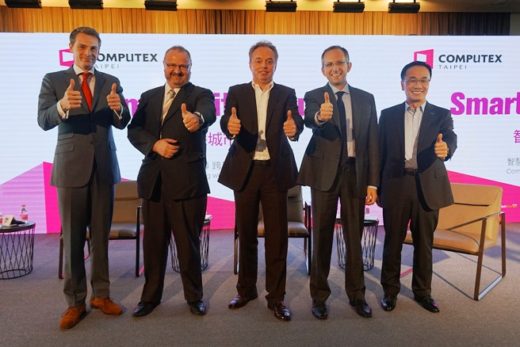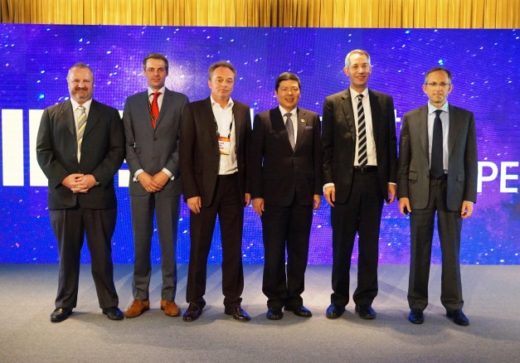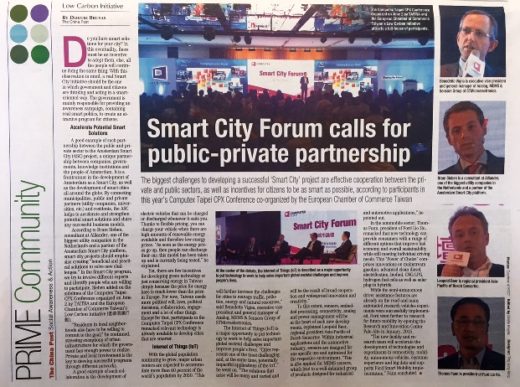LCI: 2015 COMPUTEX Smart City Forum



Opening speeches
In his opening remarks Walter Yeh, Executive Vice President, (TAITRA) said that this year's Computex, a leading international ICT show and the largest such show in Asia, was being held for the 35th year and featured 5,000 booths from 21 countries. As 30% of exhibitors were from overseas, this indicated that Computex it a truly international platform for the ICT industry.
He added that Computex is not only a procurement platform but also a stage for releasing new products while the 100 forums and speeches, such as the Smart City Forum, offered a platform for discussing industry trends and learning about the latest developments. Yeh went on to introduce the forum's speakers.In his opening remarks ECCT Chairman Bernd Barkey stated that half of the world's population already lives in cities and by some estimates this will increase to two thirds by 2050. He went on to say that rising urbanisation presents some formidable challenges but also some great opportunities. Building sufficient capacity in terms of housing, transport and communications infrastructure will be a challenge but larger populations also present an opportunity to build much better cities than we have now. Just because cities will have more people does not mean they have to be more gridlocked, more polluted and noisier than they are now. On the contrary, with the right planning and by implementing the most advanced technologies we can build cities that are safer, more efficient, quieter and greener, he said. He went on to cite some examples: By using the most advanced designs, materials, equipment and technology, it is now possible for buildings to be extremely energy-efficient and even carbon neutral. By extending and upgrading the public transport network and switching to new energy vehicles we can reduce emissions and pollution from the transport sector. In addition, we have only just begun to realise the potential of smart grids and the so-called Internet of Things to reduce our environmental impact and make our lives easier. There is also an added benefit. Besides being good for the environment and sustainability, the green economy also creates high value-added goods and services, more competitive companies, good jobs and tax revenue for the government, completing a virtuous circle. He concluded by saying that European companies in the LCI are continuously developing new and better sustainable solutions for every aspect of modern life and can offer proven technologies that could help Taiwan to cope with the challenges of rising urban growth.PresentationsTopic: Smart and connected - Cities in the Internet of Things
Speaker: Benedetto Vigna, Executive Vice President, General Manager, Analog, MEMS & Sensors Group, STMicroelectronics
Given the rise in energy and resource consumption, urbanisation creates unhealthy city climates and contributes significantly to climate change. According to Vigna, with smart cities we can do more with less. The smart city is built on awareness and some elements of real-time control critical city infrastructure. The city's residents and their "smart things" are key actors in enabling the smart city to do more with less.
Cities represent one of the most challenging and, at the same time, potentially impactful applications of the Internet of Things. Rising urbanization presents great opportunities for many players. The solutions that arise will be many and varied and will be the result of broad cooperation and widespread innovation and creativity. Besides having to meet the needs of more people, there will also be additional challenges related to demographics as additional services will be needed for aging populations.
We need to make city infrastructures smarter. Vigna cited examples such as smart street lighting, which dims or turns off automatically when no one is around and turns on or brightens when people are present. This not only lowers power consumption but also helps to make people feel safer. Smart lighting requires microcontrollers and sensors, an area where ST has considerable expertise and experience.
The next big thing after smart phones will be smart driving, which will make driving safer, more efficient and greener. By utilizing a combination of active safety radar systems, multi-constellation satellite navigation and secure car-to-car and car-to-infrastructure communication, carmakers are already implementing semi-autonomous systems to make driving safer and more efficient by finding the best route to avoid traffic and minimize fuel consumption. Meanwhile, completely autonomous self-driving cars are no longer the stuff of science fiction. Smart parking systems are already in use to help drivers to find a parking spot faster and enable cities to manage their parking spaces more efficiently, thereby saving time, reducing fuel consumption and pollution and traffic congestion. Smart driving also gives drivers more control and flexibility. Both smart parking and driving require many different kinds of sensors.
Smart metering allows power generators to match consumption in a more efficient way and give users more control over their usage. Smart metering provides real-time information for consumers, real time consumption, quality and outage information for providers and allows for more flexible tariff schemes and billing.
Sensors in connected garbage containers that monitor the amount of rubbish can enable cities to manage collections more efficiently and provide better services. By having the data, garbage only needs to be collected when necessary. Cities can thereby avoid overfilled containers (which would lead to user frustration and dumping) and can improve their garbage fleet management.
Smart cities will have smart homes. Connected appliances open the way for numerous possibilities to improve efficiency and convenience.
There are five important things that will enable smart cities: smart sensor systems, smart personal devices, smart actuating systems, big data processing and smart energy. The building blocks of smart systems are sensors and actuators (such as motion MEMS, environmental sensors and microphones), processing, connectivity, interfaces and power. There has been much innovation in MEMS and sensors over the past decade at ST. Sensors will continue to drive the market but there will be more applications in the home, factories and offices and hospitals in future. These will be more important than wearables.
ST is also making advances in environmental sensors. The company introduced the world's smallest pressure sensor in a tiny package. It also introduced the world's first sensor to provide a direct digital output of the Ultraviolet Index (UVI). The company is currently working on a combined temperature and humidity sensor.
Another relatively new area is facial recognition. For this, sophisticated cameras with infrared lasers are needed to scans in 3D to recognize faces.
While large companies such as ST will remain at the forefront, Vigna expects more innovations will come from startups in the future. Barriers for developers have to be lowered in order to develop products faster. Licensing software for evaluation purposes can be a long and complicated process. In contrast with open software you can help develop products and solutions faster. ST's solution to this problem is to license software for a single-use on a specific type of hardware. Vigna concluded that the low cost of sensors makes smart cities possible. ST is working with different partners to make changes in semiconductors and realise smart cities.
Topic: Shaping the cities of the future through the sensor-based IoT
Speaker: Leopold Beer, Regional President, Asia Pacific, Bosch Sensortec
Bosch is developing solutions in response to the megatrends of urbanization, demographic changes, dealing with environmental challenges (cutting CO2 emissions and improving energy efficiency) and the individualization of products and services. With the Internet of Things, all domains will merge and everyone and everything will be connected. In the IoT world, the number of potential devices is almost unlimited.
While the technology and potential for IoT is already available, why is IoT not yet a reality? One reason is that there is no IoT solution integrator. This is why Bosch is working on software innovations to enable IoT in the areas of energy, mobility, manufacturing and smart homes. In addition, there is a need for IT infrastructure to manage input from multiple devices and handle business process management, data storage, analysis and reporting, among other things. IoT will need devices, management and big data management, hardware and protocol infrastructure.
Sensor nodes are the enables of IoT. Bosch is the world's leading MEMS sensor solution supplier and pioneer. For example, there are more than 50 MEMS sensors in every car to handle safety, engine management and comfort but even more will be needed for smart cars and autonomous driving. According to Beer, smart phones account for the biggest use of MEMS sensors and they will remain the main market driver for the immediate future given the need for reliability, size shrinkage and low power consumption. However, there has been a huge evolution of MEMS and this will continue. Given the advances in technology (continuing shrinkage in size and power consumption and integration) and the multiple potential applications in IoT, the potential size of the sensor market is enormous.
Beer expects we will see more segmentation of the market, for example smart phones, automotive, wearables, home and factory automation. There may be many killer applications. In total, the market will be much bigger than the smart phone market now.
Beer noted that not everything needs to be smart and we should not waste resources developing things that human senses already do. Rather than creating solutions that substitute human senses, development should focus on bringing additional senses to things. We should be trying to enhance our senses, for example by measuring and monitoring UV rays (which human senses cannot do).
While great advances have been made, there are areas where improvement is needed. For example, Beer said that the battery life for wearable devices is still not good enough, which is why wearables are still not so popular. Besides developing better sensors, sensors need to be integrated together with sophisticated software that can measure and analyse data. For example, a sophisticated package of environmental sensors and software is needed to measure air quality.
Topic: Smart mobility for a sustainable world
Speaker: Thomas Fann, President, Ford Lio Ho Motor Company
Four megatrends are shaping the future of mobility: Urbanisation (huge and growing cities), a growing middle class (many more people will want to drive cars), air quality (while cars are not the only cause of air pollution, they are a big contributor) and changing consumer attitudes (millennials behave differently from previous generations, especially regarding mobility).
This year Ford announced a smart mobility plan covering connectivity, mobility and autonomous driving. Ford is conducting many experiments in technology and business models. While the company is working on new and innovative technology, the primary focus is to make mobility affordable economically, environmentally and socially.
Cars of the future will not only have much better infotainment. They must also be able to "talk" to other cars, infrastructure and the cloud. The long term focus is on improving connectivity.
Ford's strategy is to provide a wide variety of options that cater to different consumer needs, including green products. However, new energy vehicles, particularly electric vehicles are still costly. According to Fann, Ford has been investing in research on fuel cells for 50 years, spending US$100 million every year on fuel cells but new energy vehicles need to reach a critical mass before they become affordable. According to Fann, new energy vehicles will need to reach at least 10% of total market share before economies of scale will result in a meaningful drop in costs. For this reason the company is still investing heavily in enhancing the efficiency of internal combustion cars. A major component of this is to make vehicles lighter with increasing use of light-weight materials such as aluminium and plastic. In addition, materials need to be sustainable, either from sustainable sources or recyclable. Ford uses a lot of recycled and recyclable materials in its vehicles.
Besides developing vehicles, the company is working with partners in other fields. For example, it is working with utility companies to develop a system to manage the recharging of electric vehicles more effectively to find ways to prevent power overloads that would overload the grid if too many EVs were to be recharged at the same time.
Like other car companies, Ford is working on integrating semi-autonomous driving features in many cars such as advanced systems incorporating radar and sensors that can sense objects in the way and slow down or stop automatically to maintain a safe distance, recognize speed limit signs and adjust speed automatically and adjust steering direction to keep cars within lanes. When cars are connected, if one stops suddenly it can send a signal to surrounding vehicles so they can take preventive action. Fann showed a video demonstrating Ford's self-parking system, whereby a car can find a vacant parking space and park by itself.
Ford is experimenting with various business models, including car sharing models for different markets, including Germany, the UK and India. Connectivity between vehicles will provide great opportunities as well as data which could be very valuable. However, there are still a number of challenges to overcome. For example, details on the legal and regulatory framework need to be worked out. For example, if two autonomous cars collide who is legally responsible? What role should government play? Also, in terms of IT infrastructure, if millions of cars start communicating with one another, will the system be able to handle the data load? There are also privacy and security issues to work out. If cars are connected, would someone be able to hack into and hijack someone else's car? Finally, if the trend is towards fully-electric vehicles, to be truly green we also need a green (renewable energy) power source for electric cars.
Topic: Amsterdam's Smart City programme
Speaker: Bram Sieben, Strategist, Smart Cities, Alliander NV & Amsterdam Smart City
Sieben introduced Amsterdam's Smart City programme, a public-private collaborative effort initiated in 2009 to transform Amsterdam into a smarter city by actively engaging public, semi-public and private organizations. The programme places strong emphasis on openness, by facilitating open data, creating open infrastructures and actively collaborating with other cities and organizations to allow developers to create and share smart city concepts. The city government is only responsible for one seventh of smart city projects, indicating the degree of collaboration with other partners. The focus is always user-centered to ensure that projects are catering to what people really want.
Connectivity is a key requirement for realizing smart cities and Amsterdam is well-positioned in this regard as the second largest internet hub in the world with 95% of households connected to the internet. Another important feature is open data.
Sieben introduced a number of examples of smart projects in the city. The city has several smart grid and energy management pilot projects, and an energy research centre. The city has had one of the most advanced roll-outs of smart grids in the world, incorporating smart metering and self-healing grids. The city has introduced advanced technology for buildings. Many buildings generate energy and some households are already energy neutral. Innovative solutions have been adopted to both heat and cool buildings. For example, the business district of Zuidas is cooled by water from a lake and heated by water from an energy plant. The city is working on cooling Schiphol Airport with water. In addition, Amsterdam has a lot of data centres, which use a lot of power and generate a lot of residual heat. This is used to warm houses. Amsterdam also has a pilot project for electric cars that can both be recharged or discharge electricity if the price is right.
Waste also provides an opportunity. Besides recycling, the city has found a way to use waste. The Afval Energie bedrijf (AEB) waste-fired power plant has an electrical efficiency of 30%, which is 8% higher than the average waste-to-energy plant. 48% of the waste consists of biomass. AEB currently produces electricity for 320,000 households.
Another project is a dynamic traffic control system to monitor and manage traffic. The system allows emergency vehicle drivers to find the most optimal route, depending on traffic conditions.
The city is a pioneer in rolling out electric vehicle infrastructure and has several car sharing schemes in place. For example, the car2go has proven to be a successful business model. All 300 of the car2go cars in The Netherlands are plug in electric models. There are also a number of sharing projects related to health and insurance and even Apps for something as simple as borrowing a ladder.
E-health offers tremendous opportunities given the rapidly-aging population. Hospitals and insurance companies have a lot of data but they are not sharing it. There is also potential for tapping geothermal energy. Over 100 partners have an active role in pilot projects to address challenges in the city. There are so-called "urban living labs" in three areas of the city.
Sieben offered a summary of lessons learned. Smart cities are about collaboration. It helps to have an independent entity as the coordinator between public and private players to enable new partnerships and settle proprietary issues on data. Parties need to capitalize on the "political cycle", meaning they need political sponsorship and government orchestration. Projects should make the best use of resources by utilizing what has already been created by others instead of starting from scratch.
Sieben concluded that successful development needs transparency and collaboration, both at a local and international level. Products and services must be user-centric. Livability increases with Apps. Finally, there is a paradigm shift underway, which is especially apparent in the millennial generation, away from ownership to availability or sharing. Smart city developers need to be cognizant of this trend.
